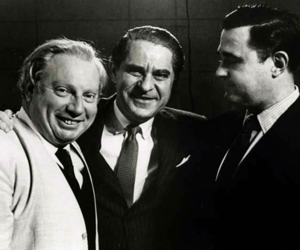Great musicians such as Adolf Busch, Pablo Casals and Bruno Walter recognized him as one of their peers and welcomed him into the small circle of the “chosen ones”. Considering himself to be first a man before being a musician, a lover of art and literature, highly engaged in political life, he refused to make concessions to marketing and the star system. This did not prevent him from having an immense career, with more than four thousand concerts. His activity in chamber music sometimes overshadowed his image as a soloist, but the publication of his complete recordings of concertos and solo piano has restored him to his rightful place amongst the greatest pianists of the twentieth century.
This site relives his musical path, but also that of his human adventure, which is perhaps even more fascinating. Eugene Istomin was the symbol of a man and artist torn between different cultures (Russian, American, German, and French!) and confronted with the great upheavals of the last century. From this he drew a profound richness, a desire to live and take action, an amazing mixture of realism and optimism, and the fierce will to preserve his freedom and ideals.
Some 200 articles, more than 600 pages of text, 1000 photos, 250 audiovisual documents are not too many to cover not only all the areas of his musical activity, but also the immense field of his wide-ranging curiosity, passions and friendships.
Chopin, Scherzo No. 1 in B minor Op. 20. Eugene Istomin at Montreux Festival. September 27, 1989.
Schubert, Sonata in D major D. 850, third movement. Eugene Istomin filmed in studio (1974)
This site is dedicated to Marta Casals Istomin. Without her kindest support, this project would not have been possible.
My gratitude goes to Ruth Miura and Teresa Montañez, who patiently revised my flawed English – a daunting task!
With heartfelt thanks to all those who, over the years, have contributed to this project: José Alfaro, wonderful collector of Casals’ and Istomin’s recordings; James Gollin, with whom I collaborated on his biography entitled Pianist, a Biography of Eugene Istomin and whose timely interviews were a great help to me; David Henry, who created the first eugeneistomin.com website; and to all those whose contributions gave rise to articles: Avigdor Arikha, Yefim Bronfman, Leon Fleisher, Jaime Laredo, Tali Mahanor, David Oppenheim, Jean-Bernard Pommier, Mstislav Rostropovich, Jerzy Semkow, Pinchas Zukerman…
My greatest appreciation goes to Sébastien Van Loock and his staff for their commitment and talent in designing and developing this website which intends to be progressively enriched with new articles, photos, videos and documents, notes on sources, links, and new functionalities.
I will gratefully welcome any corrections, additional information, testimonials, photos and recordings.
Bernard Meillat













